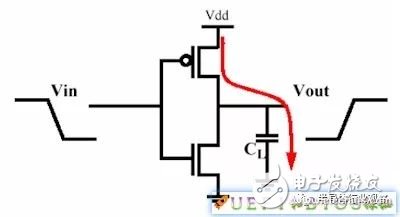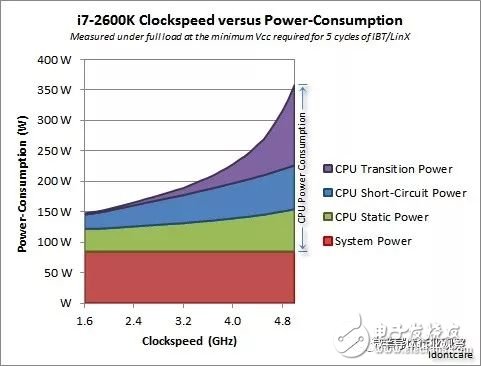Looking back on 2004, Intel is ambitious, and the Pentium 4, which announced that the code is Prescott's long pipeline, will release a 4GHz CPU. But the end result is 3.8GHz for various reasons. After that, the clock speed did not go backwards until the Core 4 generation (4790K), code-named Haswell, really stood on 4GHz. The successors of Broadwell, Skylake, Kabylake and Coffeelake became ineffective. Time has passed for more than ten years, why can't the CPU frequency continue to improve? What happened? Have we already reached the frequency ceiling?
Through the previous article (the second thing that CPUs make: Die's size and yield), we know that we want to improve the computing power of the CPU, not simply by stacking the kernel. So can you simply increase the CPU clock speed and let the CPU calculate the result faster for each core? Why is Intel holding the CPU process of the ear, no longer brave to climb the peak frequency? In fact, the bottleneck is mainly in heat dissipation. Let's take a closer look at the reasons.
Why does the CPU heat up?
From Pentium 4 with 140 million field-effect transistor FETs to Kabylake with more than 8 billion, Intel has faithfully increased the number of transistors according to Moore's Law. Such multiple FETs are consuming energy with each flip. A simple schematic of a FET is as follows:

When the input is low, CL is charged, and we assume that the energy of a joule is stored in the capacitor. When the input goes high, the power is released and the energy of the a joule is released. Because CL is small, this a is also very small and almost negligible. But if we flip this FET at 1GHz, the energy consumption is a × 10^9, which can't be ignored. Adding billions of FETs in the CPU, the energy consumed is quite considerable.
Energy consumption and frequencyFrom the illustration, you may intuitively see that energy consumption and frequency are positively correlated. This understanding is correct, in fact the energy consumption and frequency are linearly related. The public relations relationship is (Reference 2):

P stands for energy consumption. C can be thought of simply as a constant, which is determined by factors such as the process; V is the voltage; and f is the frequency. Ideally, by doubling the frequency, the energy consumption is doubled. It doesn't look very serious, isn't it? But the actual situation is not that simple.
We are here to introduce the concept of Gate Delay. Simply put, it takes a certain amount of time for the FETs that make up the CPU to charge and discharge. This time is the gate delay. The signal integrity can only be guaranteed after sampling is completed. The charge and discharge time is negatively correlated with the voltage, that is, the voltage is high, and the charge and discharge time is short. It is also positively related to the process, that is, the smaller the process, the shorter the charge and discharge time. Let us remove the interference factor of the process. When we continue to increase the frequency f, after a certain node, too fast flipping will cause the gate delay to keep up, thus affecting the integrity of the digital signal, thus causing errors. This is also the reason why overclocking to a certain stage will be unstable and random errors will occur. So what should I do? Smart you may think of the usual method of overclocking: pressurization. By the way, you can increase the voltage to reduce the gate delay and stabilize the system.
Let's go back and look at the formula. You will find that the voltage and power consumption are not linearly related, but squared! Multiply by f, the situation is even worse. We increase the frequency and have to increase the voltage, resulting in a substantial increase in P! We recall the function graph of y=x^3 that we have learned in the middle school:

Y will start to rise steeply at point a after a slow increase in the previous period. This a is the turning point. If you pass it, you won't be able to make it. The relationship between power consumption and frequency is also so large. Let's look at two practical examples:

i7-2600K frequency and power consumption

Exynos frequency and power consumption
From the ARM and X86 camps, are their energy consumption curves similar to power function diagrams?
Other factors that cannot be ignored
The reality is more complicated than this. In fact, the P in the above formula is just dynamic energy consumption. The overall power consumption of the CPU also includes short-circuit power and leakage power:

The short-circuit power consumption is that when the FET is turned over, there is a very short time for electrons to run away. It is positively related to voltage and frequency.
Leakage power consumption is the leakage of electrons through the MOSFET, which is related to the process and temperature.
To combine these, let's look at a practical example:

The Transition Power here is the dynamic energy consumption. It can be seen that it rises sharply with the frequency; the short-circuit power consumption and the frequency are almost linear. The Static power refers to the leakage power consumption, and it also rises because the frequency rises and the temperature rises. Leakage increases.
Here we introduce the concept of heat density, which is the amount of heat emitted per unit area. It can be seen from this figure that as the frequency increases, the superposition of various factors leads to a serious increase in power consumption, and the chip size does not change, so that the heat density increases rapidly, and the existing heat dissipation device does not discharge so much heat in a short time. It will cause a crash, etc. (What happens after the CPU fan stops? The CPU does not burn properly). This is why overclocking often requires good cooling equipment (hands over to overclock one: upgrade the cooling system).
a brain hole
We finally opened a brain hole: assuming there is no heat problem, no door delay, in a perfect world, is there a limit to the frequency? This is a very interesting reflection. Everyone knows that electrical signals travel very fast in the wire, close to the speed of light. We take the speed of light here: 300,000 kilometers per second. I believe that everyone who knows the theory of relativity knows that the speed of light is the physical limit. We don't discuss sci-fi problems here. Because there is no gate delay, the electrical signal propagates at the speed of light. The speed of light, this number is very large, but our frequency can be in G, which is 10^9, which is also very large. In the case of 1 GHz, the electrical signal can only propagate 30cm! At 10 GHz, it can spread 3 cm. The wafer size is 300mm. If we make a CPU as big as it is, maybe the maximum frequency is only 1GHz. And now the die size of the CPU is almost 1cm, so in theory 30GHz is the limit frequency!
in conclusion
With the support of liquid nitrogen cooling, the CPU frequency can challenge 9GHz with the help of extreme players. This is very far away for our daily computer users. In the foreseeable future, CPU frequency will not increase significantly due to heat density. We may never see a 10GHz silicon-based CPU. Perhaps only when you abandon silicon or switch to quantum computing, the CPU frequency will change dramatically.
This does not mean that the CPU performance is not stopped. In fact, the current CoffeeLake 3.8G CPU is more than ten times better than the Pentium 4's 3.8G, and the Benchmark performance is reduced by a dozen times. This is a blessing to improve the architecture. After absorbing the depth of the netburst to improve the frequency, but was praised as the high-frequency low-energy Pentium 4 lessons, this is also the direction of Intel and other chip manufacturers.
Vacuum UV Curing Machine,Vacuum Curing Machine,UV Machine
Shenzhen Jianjiantong Technology Co., Ltd. , https://www.morhoh-sz.com